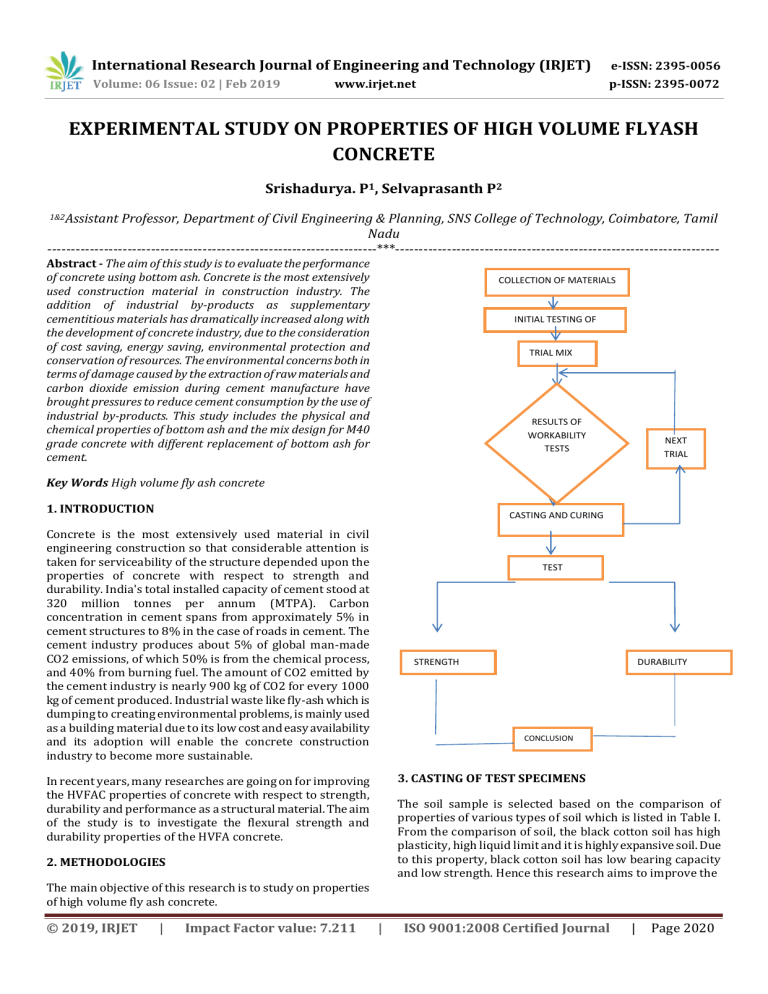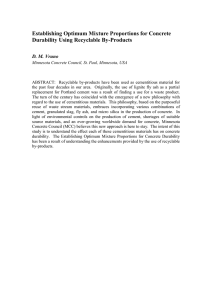IRJET-Experimental Study on Properties of High Volume Flyash Concrete
advertisement

International Research Journal of Engineering and Technology (IRJET) e-ISSN: 2395-0056 Volume: 06 Issue: 02 | Feb 2019 p-ISSN: 2395-0072 www.irjet.net EXPERIMENTAL STUDY ON PROPERTIES OF HIGH VOLUME FLYASH CONCRETE Srishadurya. P1, Selvaprasanth P2 1&2Assistant Professor, Department of Civil Engineering & Planning, SNS College of Technology, Coimbatore, Tamil Nadu ----------------------------------------------------------------------***--------------------------------------------------------------------Abstract - The aim of this study is to evaluate the performance of concrete using bottom ash. Concrete is the most extensively used construction material in construction industry. The addition of industrial by-products as supplementary cementitious materials has dramatically increased along with the development of concrete industry, due to the consideration of cost saving, energy saving, environmental protection and conservation of resources. The environmental concerns both in terms of damage caused by the extraction of raw materials and carbon dioxide emission during cement manufacture have brought pressures to reduce cement consumption by the use of industrial by-products. This study includes the physical and chemical properties of bottom ash and the mix design for M40 grade concrete with different replacement of bottom ash for cement. COLLECTION OF MATERIALS INITIAL TESTING OF MATERIALS TRIAL MIX DESIGN RESULTS OF WORKABILITY TESTS NEXT TRIAL MIX Key Words High volume fly ash concrete 1. INTRODUCTION CASTING AND CURING Concrete is the most extensively used material in civil engineering construction so that considerable attention is taken for serviceability of the structure depended upon the properties of concrete with respect to strength and durability. India's total installed capacity of cement stood at 320 million tonnes per annum (MTPA). Carbon concentration in cement spans from approximately 5% in cement structures to 8% in the case of roads in cement. The cement industry produces about 5% of global man-made CO2 emissions, of which 50% is from the chemical process, and 40% from burning fuel. The amount of CO2 emitted by the cement industry is nearly 900 kg of CO2 for every 1000 kg of cement produced. Industrial waste like fly-ash which is dumping to creating environmental problems, is mainly used as a building material due to its low cost and easy availability and its adoption will enable the concrete construction industry to become more sustainable. TEST ONCUBECUBECO NCRETE STRENGTH STUDIES DURABILITY STUDIES CONCLUSION 3. CASTING OF TEST SPECIMENS In recent years, many researches are going on for improving the HVFAC properties of concrete with respect to strength, durability and performance as a structural material. The aim of the study is to investigate the flexural strength and durability properties of the HVFA concrete. The soil sample is selected based on the comparison of properties of various types of soil which is listed in Table I. From the comparison of soil, the black cotton soil has high plasticity, high liquid limit and it is highly expansive soil. Due to this property, black cotton soil has low bearing capacity and low strength. Hence this research aims to improve the 2. METHODOLOGIES The main objective of this research is to study on properties of high volume fly ash concrete. © 2019, IRJET | Impact Factor value: 7.211 | ISO 9001:2008 Certified Journal | Page 2020 International Research Journal of Engineering and Technology (IRJET) e-ISSN: 2395-0056 Volume: 06 Issue: 02 | Feb 2019 p-ISSN: 2395-0072 www.irjet.net 4. CASTING OF TEST SPECIMENS Mix proportion for per m3: Table 1 HVFA composition mix Cement Fly Ash Fly Ash Fine Aggregate Coarse Aggregate w/c water super plasticizer 1 448 0 0 732 1125 0.330 148 2.240 2 268 40 180 732 1125 0.330 148 2.240 3 224 50 224 732 1125 0.330 148 2.240 4 180 60 268 732 1125 0.330 148 2.240 The concrete cubes of size 15 cm x 15 cm x 15 cm were cast by using conventional concrete. The specimens were de-moulded after 1 day and immersed in water for 7, 28 days for curing. After 7 and 28 days concrete cubes were tested as per IS 516 – 1956. The test was conducted in compression testing machine. The load was applied at the rate of approximately 140 kg/cm2/min until the failure of the specimen. The maximum load applied to the specimen until the failure was recorded Table 2 Cube test for Mix design S.NO W/C RATIO CEMENT SAND COARSE AGGREGATE 28 days 38 0.364 407 752 1131 25 A2 0364 407 752 1131 26 A3 0.364 407 752 1131 25.5 40 B1 0.330 448 732 1125 28.8 40 B2 0.330 448 732 1125 27 B3 0.330 448 732 1125 28 2. REFERENCES Impact Factor value: 7.211 27.9 38 39 38.67 39.67 40 Concrete”,IJIRSET C-H Huang et al, “Mix proportion and mechanical properties of concrete containing very high volume of Class F fly ash”, Concrete and building materials 46 (2013) 71 – 78. 3. IS: 10262-1982, Guidelines For Concrete Mix Proportion, Bureau Of Indian Standards, New Delhi, India. Adanagouda,Shashikumar.B,“Experimental Investigation on Strength Characteristics of Fly Ash Based High Performance Concrete with Steel Fiber and | 25.5 Polypropylene Fiber”, IJIRSETVol. 4, Issue 9, September 2015. The 7 and 28 days test results for concrete from that the water – cement ratio of 0.330 gives a maximum compressive strength then to adopt the mix design for M40 is448 : 732 : 1125 : 0.330. © 2019, IRJET 7 days A1 CONCLUSION: 1. COMPRESSIVE STRENGTH N/mm2 | ISO 9001:2008 Certified Journal | Page 2021 International Research Journal of Engineering and Technology (IRJET) e-ISSN: 2395-0056 Volume: 06 Issue: 02 | Feb 2019 p-ISSN: 2395-0072 www.irjet.net 4. IS: 383-1970, Specifications For Coarse Aggregates And Fine Aggregates From National Sources For Concrete, Bureau Of Indian Standards, New Delhi, India. 5. IS: 12269-2013, Ordinary Portland cement, 53grade – Specification, Bureau of Indian Standards, and New Delhi, India. 6. IS: 3812-2003Part (II), Pulverized Fuel Ash — Specification, Bureau of Indian Standards, and New Delhi, India. 7. Kolli.Ramujee,“Strength Properties of Polypropylene Fiber Reinforced, Vol. 2, Issue 8, August 2013. 8. Narendra B.K., T.M.Mahadeviah ,“Flexural behavior of Reinforced Fly Ash Concrete in Comparison to Reinforced Normal Concrete beams in Terms of Cracking Load and Ultimate Load Carrying Capacity”,ISSN: 2249 – 8958, Volume-4 Issue-2, December 2014. 9. O.Kayali,“Effect of high volume fly ash on mechanical properties of fiber reinforced concrete”, Materials and structures 37 (2004) 318 – 327. © 2019, IRJET | Impact Factor value: 7.211 | ISO 9001:2008 Certified Journal | Page 2022


